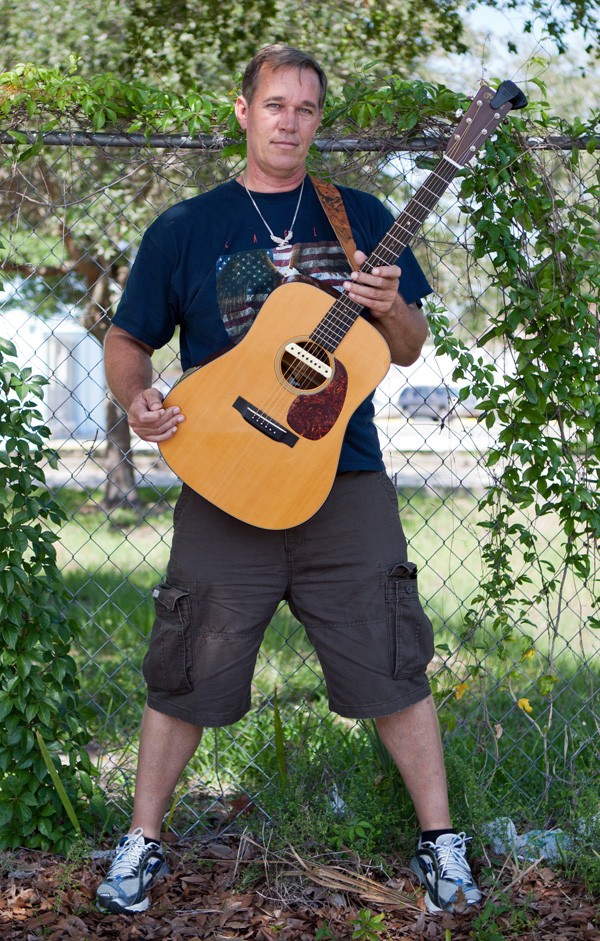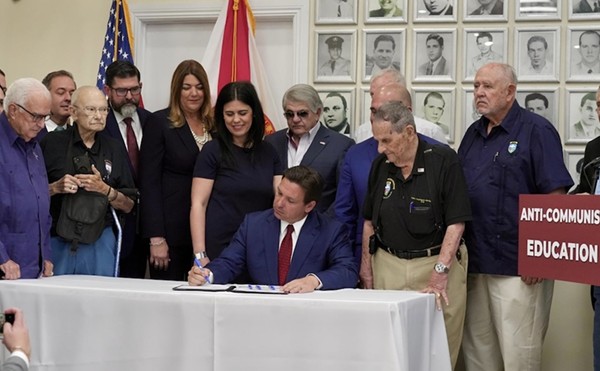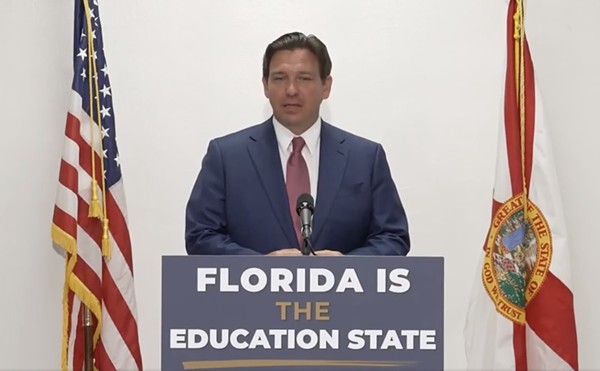On Nov. 18, 2008, William Dillon finally went swimming. Upon arriving at his brother’s backyard pool, the burly 49-year-old hurled his 6-foot-4-inch, 245-pound frame into the chilly water, not even bothering to take off his jeans or shoes. His younger brothers, Joe and David, joined him, also fully clothed, on that fall evening. It was an unconventional, but utterly appropriate celebration: Earlier that day, Dillon was released from the Brevard County Detention Center, where he ended his incarceration of nearly 27 years.
“You don’t get to swim in prison at all,” Dillon says. “You get a shower, of course, but that’s it.”
Dillon talks about his years behind bars without a hint of anger – surprising, considering he didn’t belong there in the first place. Convicted of murder as a shaggy-haired 22-year-old, Dillon was exonerated of the crime in 2008, after a scientific analysis found that a bloody T-shirt used as the main piece of evidence against him bore none of his DNA. Nearly three years after celebrating his freedom, however, the past still haunts him. He’s been waiting for financial compensation from the state, a payout that was hamstrung by a renewed investigation by the Brevard County Sheriff’s Office. In addition, this month will not only mark Dillon’s 52nd birthday – “I’ll be 24 as a free man,” he says – but the release of his first music album, Black Robes and Lawyers, which draws heavily on his experiences in prison. The Aug. 16 album release date comes just a day shy of the 30-year anniversary of the murder that put him behind bars.
Dillon is now seeking justice – not only for himself, he says, but for those like him put behind bars due to shoddy evidence and what he argues is flagrant misconduct by law enforcement. Since 2000, 13 people convicted in Florida have been exonerated of crimes by DNA evidence, and two of them were convicted in Brevard County. As soon as Aug. 23, the 18th Judicial Circuit Court will decide whether another alleged killer, Gary Bennett, should be freed after spending more than a quarter of a century in prison. He was also arrested in Brevard County in the early 1980s, investigated and prosecuted by many of the same people who cost Dillon the majority of his adult life. “They try to keep innocent people in prison to make themselves not look bad,” Dillon says.
On Aug. 17, 1981, the body of 40-year-old James Dvorak was discovered in the brush near Canova Beach. A medical examiner later estimated that Dvorak had been beaten to death between 1:30 and 3:30 a.m. that same morning. A man named John Parker was driving in the area around that time and picked up a shirtless hitchhiker along state road A1A, who identified himself as “Jim.” The next morning, Parker found in his truck a T-shirt stained with blood, which he threw in a trash bin. When Parker learned about the murder, he contacted police and led them back to the shirt.
Five days later, Joe Dillon pulled his black Monte Carlo into the parking lot across the street from the Pelican, a bar not far from the crime scene. William was in the passenger seat, smoking a joint. “A man and older woman come up to the car and say: ‘We’re sheriff’s department,’” William Dillon says. “I freak out; I’m putting out the joint in the palm of my hand.”
The visibly nervous Dillon, who skipped out on the police interview requested of him the following day, soon became not only a suspect, but the suspect. During questioning, Dillon was asked to crumple up a piece of paper. A dog handler named John Preston, contracted by the sheriff’s office, said that his German shepherd, named Harass II, matched the scent of Dillon from the paper to the T-shirt. In 1984, Preston left the county after his dog failed a simple scent test. An investigative report later that year aired by 20/20, which firmly established his reputation as a fraud, guaranteed he would not find work anywhere else in the country. (For more details about the investigation, see our Oct. 11, 2007, feature, “26 years,” which Dillon credits as “getting the ball rolling” for his release.)
The day after Dillon was indicted, the Brevard County Sheriff’s Office received an anonymous tip that a man named James Johnstone had likely committed the crime. The note was quietly filed away, only to be acknowledged decades later. (The Brevard County Sheriff’s Office says it does not know who filed the tip, but Dillon suspects it is a closely guarded secret.)
Despite Harass II’s scent match and a puzzling array of witnesses who claimed they saw a shirtless Dillon at the Pelican just after Dvorak’s death, the case against Dillon at first appeared weak. The description of the hitchhiker John Parker encountered did not seem to match Dillon at all. One of the prosecution’s chief witnesses, a woman named Donna Parrish whom Dillon had casually dated, changed her story several times throughout the trial; in addition, she had sex with the chief investigator of the case. “It just didn’t seem possible that he was going to be found guilty,” Dillon’s father, also named Joe, says.
Joe Sr. was so convinced of a forthcoming acquittal that he didn’t even bother to stay for the verdict when the jury went into deliberations on Dec. 4, 1981 – he did however, write a brief letter thanking the jurors. But the verdict that was announced an hour and a half later was the unthinkable: guilty of first-degree murder. Dillon’s sister, Debbie, was sitting two rows behind him. “I had to be led out of the room,” she says. “I had lost it. I didn’t even see them take him off.”
Within the first hour of his life sentence, Dillon was gang-raped. (A week and a half later, Parrish recanted her testimony against Dillon, stating she had been pressured by police.) As the years wore on, he says, he considered suicide. “I was just going to take a run and jump at the fence and have ’em shoot me off it,” he says. He reconsidered after noting that others had tried the same, only to be paralyzed after taking a bullet to the spine.
A little more than halfway through his time in prison, however, Dillon says he had accepted his fate: “If I never get out of here, if I never see anything, then so be it.”
But after learning about Wilton Dedge, another Brevard County man (and also one of Harass II’s subjects) who won his freedom in 2004 after DNA testing cleared him of rape, Dillon applied in 2007 to have the evidence in his case tested. To his surprise, Brevard County Circuit Judge David Dugan accepted the motion. After hearing the news, the Florida chapter of the Innocence Project, an organization that evaluates wrongful incarceration claims based on DNA evidence, got involved. In conjunction with Dillon’s public defender, the group’s attorneys requested everything from strands of hair to soil samples, but the Brevard County Sheriff’s Office claimed that practically everything had been lost. Luckily for Dillon, a key piece of evidence – the bloody T-shirt – had been left with the court clerk’s office.
In July 2008 DNA testing confirmed that Dillon could not have worn the shirt. In November of that year he was released on bond, but the county, contending that the testing results did not necessarily exonerate him, filed for a retrial. Yet less than a month later, the state dropped its charges, arguing that too many of the witnesses in the original trial had since died.
Dillon’s life after prison was far from glamorous – he performed heavy labor for an auto parts company and lived with his brother Joe, who says Dillon would keep to himself in his room, sleep and wake at the exact same time daily, and would not eat until he was served a meal. “He would pretty much wait for us to tell him it was OK to do something,” Joe says.
Dillon came out of his shell in March 2009, when he traveled to Houston to attend an Innocence Project conference. There Dillon met Ellen Moscovitz, who at that time was the head of a DNA-testing company. The two fell in love, and Dillon promptly moved to Cincinnati with Moscovitz, who encouraged him to pursue music as a career – while in prison, Dillon learned to play guitar and wrote numerous songs. He returned to Florida on Nov. 2, 2009, for his compensation hearing before the Florida state legislature. It was then that Roger Dale Chapman, who had briefly shared a jail holding cell with Dillon, told legislators that he was coerced by police to fabricate his original testimony, in which Dillon confessed to him of murdering Dvorak.
The following day, Brevard County Sheriff Jack Parker declared that his office was reopening the investigation.
Dillon and Moscovitz had since left Ohio and were living in Chapel Hill, N.C. On the evening of Nov. 3, 2010, two detectives from the Brevard County Sheriff’s Office arrived at their front door. Moscovitz says that because the detectives “acted like they were just trying to get him paid by the legislators,” they let them come inside. But what followed, according to the couple, were allegations that there was photographic evidence of Dillon’s presence near the Pelican that night, despite his contention that he was in Cocoa Beach. In June, the Brevard daily newspaper Florida Today reported the county’s investigators believed that Dillon “may have robbed someone the night of the killing or even taken money from the dead or dying Dvorak.”
Dillon says doubts surrounding his innocence have been manufactured by the sheriff’s office to shield itself from potential litigation and the disgrace of its own wrongdoing – he notes that the alleged photos never materialized. Still, the shadow cast over him has affected his compensation. In 2009 Dillon and his attorneys petitioned the legislature for a sum of $1.35 million dollars, or $50,000 per year of incarceration, which is consistent with state law for financial redress of wrongful convictions. Yet on Feb. 1 of this year, the Florida Senate’s special master on claim bills recommended that Dillon be given only $810,000, or $30,000 for each year he was incarcerated. Because Dillon was caught with a quaalude pill at age 19 – and subsequently charged with a felony – he did not meet the requirements of the state’s “clean hands” clause, and hence, was ineligible for statutory compensation. The special master also wrote that Dillon’s lawyers failed to demonstrate his “actual innocence” in the Dvorak killing.
On June 20, however, the Brevard County Sheriff’s Office announced four new suspects in the Dvorak slaying – chief among them James Johnstone, whose DNA matched that found on the shirt, whose attributes closely fit the description given by the hitchhiker and whose name was on the brief tip unearthed from Dillon’s decades-old file. (Lt. Tod Goodyear of the Brevard County Sheriff’s Office says that investigators involved with Dillon’s 1981 case were “floored” when they saw the tip – apparently, they had no idea it existed.) Because the state attorney for Brevard County, Norm Wolfinger, was an assistant public defender for the county at the time of Dillon’s case, the reopened case was transferred to the 7th District Court in Daytona Beach to avoid a conflict. According to the court’s spokeswoman, Shannon Peters, the case is still under “active” investigation and hence, no arrest warrant for Johnstone nor any other suspects has been issued.
Neither the sheriff’s office nor the state attorney’s office has issued an official apology for Dillon’s wrongful conviction back in 1981. “If there was an apology due, it might be due from the people involved back then,” Goodyear says, adding that all of those involved in Dillon’s original case at the sheriff’s office have either retired or died.
Given that Dillon has been officially cleared of the murder, his lawyers are now attempting to push the compensation bill, slated for a vote during next year’s legislative session, back up to the $1.35 million Dillon had originally requested.
One of those lawyers is Seth Miller, executive director of the Innocence Project of Florida. He says his organization is currently working on 35 cases, but receives roughly 1,000 requests for assistance per year. In light of the convictions of Dillon and many others, the organization has recommended several reforms to eyewitness identification procedures, but Miller also suggests that the problems with Dillon’s case go far beyond clumsy policing. “It’s the clear case of tunnel vision,” he says. “They completely ignore any evidence that is contrary to their theory that he’s the person who committed the crime.”
It’s for that reason that Dillon is considering filing a civil suit in Brevard County over prosecutorial and police misconduct, though he won’t say when. In the nearer future, he’ll be telling his story to audiences across Florida in a CD release tour slated for the coming months. Dillon sees both plans as part of a larger goal: to hold those responsible for his lost years accountable. “In reality, I was meant to take this battle on,” Dillon says. “And I’m willing to take it on.”




















